The Web-fast-access (from web-fast-access.com) is an ‘ad-supported’ software (also known as adware). The adware may alter the settings of web browsers like Edge, Chrome, Microsoft Internet Explorer and Firefox or install a harmful browser plugin which developed to generate lots of annoying popup ads. It will lead to the fact that when you browse the Internet, it’ll always be forced to display lots of unwanted Web-fast-access advertisements, even when your web-browser is configured to block advertisements or your computer has a program that blocks pop-up advertisements. On current date, the adware continues to increase the number of systems that have been infected.
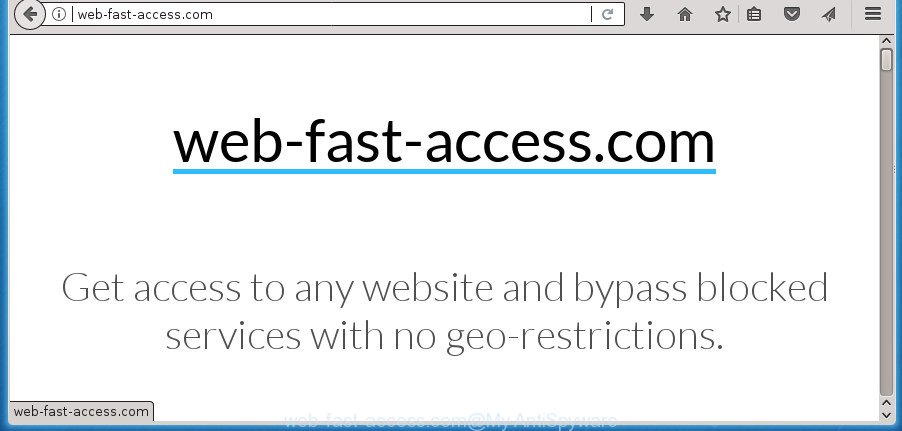
It’s probably that you might be worried with the Web-fast-access ‘ad supported’ software that redirects your web-browser to unwanted ad pages. You should not disregard this unwanted software. The ‘ad supported’ software might not only open annoying advertisements, but redirect your web-browser to malicious pages. What is more, the ‘ad supported’ software can analyze your browsing, and gain access to your personal info and, later, can transfer it to third parties. Thus, there are more than enough reasons to get rid of Web-fast-access ad supported software from your personal computer.
The adware usually affects only the IE, Edge, Google Chrome and Mozilla Firefox by modifying the browser’s settings or installing a malicious extensions. Moreover, possible situations, when any other web browsers will be affected too. The adware will perform a scan of the machine for web-browser shortcut files and alter them without your permission. When it infects the web browser shortcuts, it’ll add the argument like ‘http://site.address’ into Target property. So, each time you run the internet browser, you’ll see an unwanted Web-fast-access web-site.
Instructions which is shown below, will help you to clean your machine from the ad supported software as well as delete Web-fast-access annoying popups from the Firefox, Google Chrome, Edge and Microsoft Internet Explorer and other browsers.
Remove Web-fast-access adware (removal tutorial)
There are a few ways which can be used to remove Web-fast-access ad supported software. But, not all potentially unwanted programs like this adware can be completely deleted utilizing only manual methods. In many cases you are not able to delete any ad-supported software using standard Windows options. In order to remove Web-fast-access adware you need complete a few manual steps and run reliable removal tools. Most IT security researchers states that Zemana Anti-Malware (ZAM), MalwareBytes or AdwCleaner utilities are a right choice. These free programs are able to scan for and remove Web-fast-access from your personal computer and revert back your internet browser settings to defaults.
To remove Web-fast-access, execute the following steps:
- How to get rid of Web-fast-access adware without any software
- Remove potentially unwanted software using MS Windows Control Panel
- Get rid of Web-fast-access adware from FF
- Remove Web-fast-access from Internet Explorer
- Remove Web-fast-access adware from Google Chrome
- Get rid of unwanted Scheduled Tasks
- Fix internet browser shortcuts, changed by ‘ad supported’ software
- How to remove Web-fast-access adware with freeware
- Stop Web-fast-access redirect and other unwanted web-sites
- How did you get infected with Web-fast-access adware
- To sum up
How to get rid of Web-fast-access adware without any software
The following instructions is a step-by-step guide, which will help you manually delete Web-fast-access from the Google Chrome, Edge, Firefox and Internet Explorer.
Remove potentially unwanted software using MS Windows Control Panel
The best way to begin the system cleanup is to delete unknown and suspicious software. Using the Windows Control Panel you can do this quickly and easily. This step, in spite of its simplicity, should not be ignored, because the removing of unneeded software can clean up the Firefox, Microsoft Edge, Internet Explorer and Google Chrome from pop-up advertisements, hijackers and so on.
Make sure you have closed all web-browsers and other applications. Press CTRL, ALT, DEL keys together to open the Microsoft Windows Task Manager.

Click on the “Processes” tab, look for something questionable that is the Web-fast-access ‘ad supported’ software that causes multiple intrusive advertisements and pop-ups then right-click it and select “End Task” or “End Process” option. Most commonly, malware masks itself to avoid detection by imitating legitimate MS Windows processes. A process is particularly suspicious: it is taking up a lot of memory (despite the fact that you closed all of your programs), its name is not familiar to you (if you are in doubt, you can always check the program by doing a search for its name in Google, Yahoo or Bing).
Next, delete any unwanted and suspicious software from your Control panel.
Windows 10, 8.1, 8
Now, click the Windows button, type “Control panel” in search and press Enter. Select “Programs and Features”, then “Uninstall a program”.
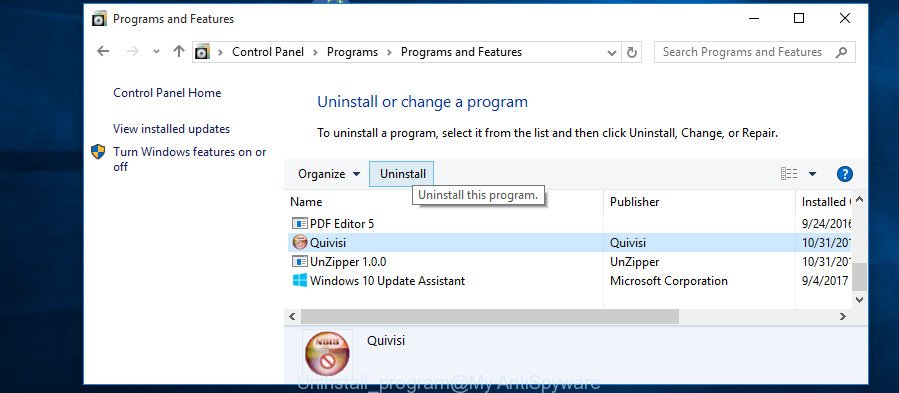
Look around the entire list of apps installed on your PC system. Most likely, one of them is the Web-fast-access that causes lots of annoying pop up ads. Choose the dubious program or the program that name is not familiar to you and remove it.
Windows Vista, 7
From the “Start” menu in Windows, select “Control Panel”. Under the “Programs” icon, choose “Uninstall a program”.

Select the dubious or any unknown applications, then click “Uninstall/Change” button to delete this undesired program from your computer.
Windows XP
Click the “Start” button, select “Control Panel” option. Click on “Add/Remove Programs”.
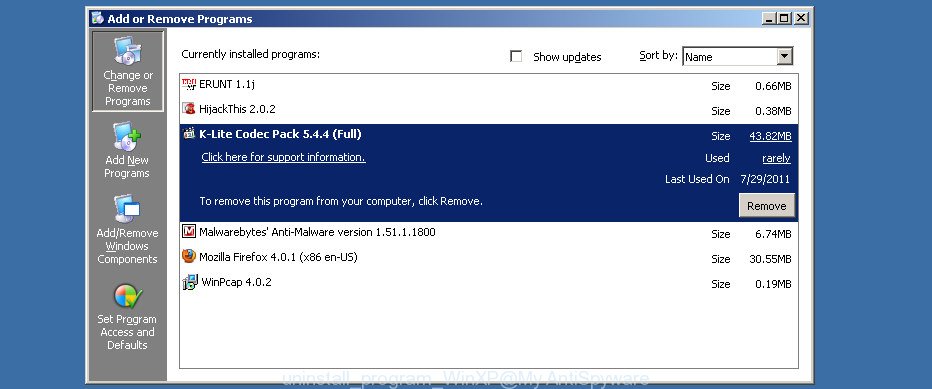
Select an undesired application, then click “Change/Remove” button. Follow the prompts.
Get rid of Web-fast-access adware from FF
If your Mozilla Firefox web browser is rerouted to Web-fast-access without your permission or an unknown search engine opens results for your search, then it may be time to perform the web-browser reset.
Run the FF and click the menu button (it looks like three stacked lines) at the top right of the web-browser screen. Next, click the question-mark icon at the bottom of the drop-down menu. It will open the slide-out menu.
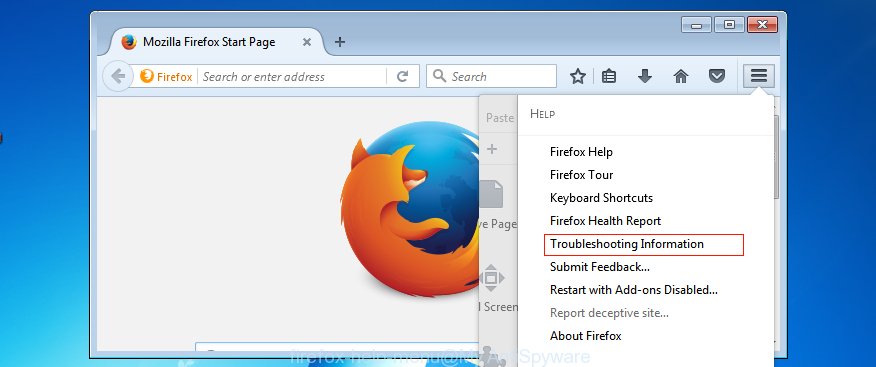
Select the “Troubleshooting information”. If you are unable to access the Help menu, then type “about:support” in your address bar and press Enter. It bring up the “Troubleshooting Information” page as displayed in the following example.
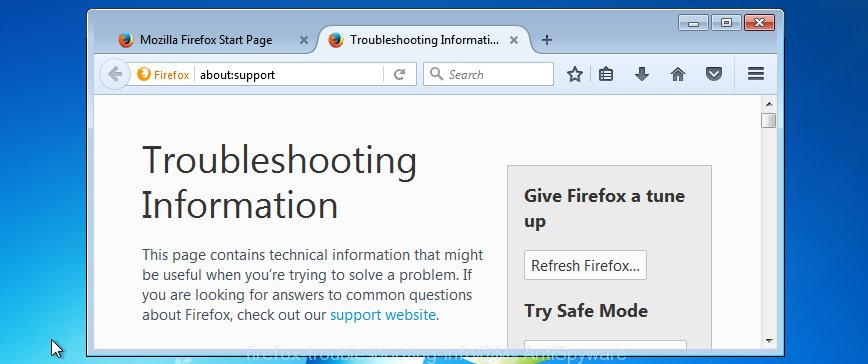
Click the “Refresh Firefox” button at the top right of the Troubleshooting Information page. Select “Refresh Firefox” in the confirmation dialog box. The FF will begin a procedure to fix your problems that caused by the Web-fast-access ‘ad supported’ software that causes web-browsers to display undesired popups. After, it’s done, click the “Finish” button.
Remove Web-fast-access from Internet Explorer
If you find that Internet Explorer internet browser settings like new tab, homepage and search engine by default having been modified by Web-fast-access ad supported software that causes web-browsers to open intrusive ads, then you may revert back your settings, via the reset internet browser procedure.
First, open the Internet Explorer, then click ‘gear’ icon ![]() . It will show the Tools drop-down menu on the right part of the browser, then click the “Internet Options” as displayed on the screen below.
. It will show the Tools drop-down menu on the right part of the browser, then click the “Internet Options” as displayed on the screen below.

In the “Internet Options” screen, select the “Advanced” tab, then press the “Reset” button. The IE will show the “Reset Internet Explorer settings” dialog box. Further, click the “Delete personal settings” check box to select it. Next, press the “Reset” button as displayed on the screen below.

After the procedure is complete, press “Close” button. Close the Microsoft Internet Explorer and restart your machine for the changes to take effect. This step will help you to restore your internet browser’s home page, newtab and default search engine to default state.
Remove Web-fast-access adware from Google Chrome
Reset Chrome settings is a easy way to get rid of the adware, malicious and adware extensions, as well as to recover the web-browser’s home page, new tab page and search engine by default that have been modified by Web-fast-access that causes tons of intrusive advertisements.
First run the Google Chrome. Next, press the button in the form of three horizontal dots (![]() ).
).
It will display the Google Chrome menu. Select More Tools, then press Extensions. Carefully browse through the list of installed add-ons. If the list has the add-on signed with “Installed by enterprise policy” or “Installed by your administrator”, then complete the following guidance: Remove Google Chrome extensions installed by enterprise policy.
Open the Chrome menu once again. Further, click the option named “Settings”.

The internet browser will show the settings screen. Another solution to display the Chrome’s settings – type chrome://settings in the web-browser adress bar and press Enter
Scroll down to the bottom of the page and click the “Advanced” link. Now scroll down until the “Reset” section is visible, as shown below and click the “Reset settings to their original defaults” button.

The Google Chrome will show the confirmation dialog box as shown on the screen below.

You need to confirm your action, click the “Reset” button. The internet browser will start the procedure of cleaning. Once it’s finished, the browser’s settings including default search provider, newtab page and home page back to the values which have been when the Google Chrome was first installed on your computer.
Get rid of unwanted Scheduled Tasks
If the unwanted Web-fast-access site opens automatically on Windows startup or at equal time intervals, then you need to check the Task Scheduler Library and get rid of all the tasks which have been created by unwanted applications.
Press Windows and R keys on your keyboard simultaneously. It will display a dialog box that called Run. In the text field, type “taskschd.msc” (without the quotes) and click OK. Task Scheduler window opens. In the left-hand side, click “Task Scheduler Library”, as on the image below.
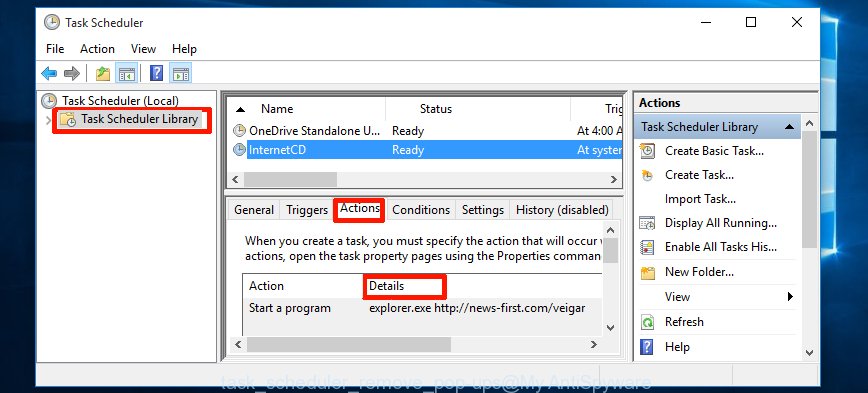
Task scheduler, list of tasks
In the middle part you will see a list of installed tasks. Select the first task, its properties will be open just below automatically. Next, press the Actions tab. Necessary to look at the text which is written under Details. Found something like “explorer.exe http://site.address” or “chrome.exe http://site.address” or “firefox.exe http://site.address”, then you need remove this task. If you are not sure that executes the task, then google it. If it’s a component of the malicious apps, then this task also should be removed.
Further click on it with the right mouse button and select Delete as displayed on the image below.

Task scheduler, delete a task
Repeat this step, if you have found a few tasks that have been created by ‘ad-supported’ program. Once is done, close the Task Scheduler window.
Fix internet browser shortcuts, changed by ‘ad supported’ software
Important to know, most anti malware apps that are able to remove Web-fast-access adware that cause annoying pop-ups to appear, but unable to search for and recover altered shortcut files. So, you need to fix the desktop shortcut files for your Firefox, Google Chrome, Microsoft Edge and Internet Explorer web browsers manually.
Right click on the internet browser’s shortcut file, click Properties option. On the Shortcut tab, locate the Target field. Click inside, you will see a vertical line – arrow pointer, move it (using -> arrow key on your keyboard) to the right as possible. You will see a text “http://site.address” that has been added here. Remove everything after .exe. An example, for Google Chrome you should remove everything after chrome.exe.

To save changes, press OK . You need to clean all web browser’s shortcuts. So, repeat this step for the FF, IE, MS Edge and Google Chrome.
How to remove Web-fast-access adware with freeware
Manual removal is not always as effective as you might think. Often, even the most experienced users can not completely remove Web-fast-access that causes internet browsers to open intrusive ads. So, we suggest to check your personal computer for any remaining harmful components with free adware removal applications below.
Automatically delete Web-fast-access ad supported software with Zemana Anti-malware
We suggest you to run the Zemana Anti-malware that are completely clean your system of Web-fast-access which reroutes your web-browser to unwanted ad pages. Moreover, the tool will help you to remove potentially unwanted software, malware, toolbars and hijacker infections that your system can be infected too.

- Visit the following page to download Zemana Free. Save it on your Microsoft Windows desktop.
Zemana AntiMalware
164783 downloads
Author: Zemana Ltd
Category: Security tools
Update: July 16, 2019
- At the download page, click on the Download button. Your internet browser will open the “Save as” dialog box. Please save it onto your Windows desktop.
- After the downloading process is finished, please close all programs and open windows on your machine. Next, start a file named Zemana.AntiMalware.Setup.
- This will start the “Setup wizard” of Zemana Anti Malware (ZAM) onto your machine. Follow the prompts and do not make any changes to default settings.
- When the Setup wizard has finished installing, the Zemana will start and display the main window.
- Further, click the “Scan” button for scanning your personal computer for the Web-fast-access which redirects your internet browser to annoying ad pages. A scan can take anywhere from 10 to 30 minutes, depending on the number of files on your computer and the speed of your personal computer. During the scan Zemana Free will find threats exist on your computer.
- As the scanning ends, Zemana Free will show a scan report.
- Review the report and then press the “Next” button. The tool will delete Web-fast-access adware that cause intrusive pop-up ads to appear and add items to the Quarantine. After the cleaning procedure is done, you may be prompted to reboot the system.
- Close the Zemana AntiMalware and continue with the next step.
Automatically remove Web-fast-access ‘ad supported’ software with Malwarebytes
We suggest using the Malwarebytes Free. You can download and install Malwarebytes to search for adware and thereby get rid of Web-fast-access from your web browsers. When installed and updated, the free malware remover will automatically scan and detect all threats exist on the PC.
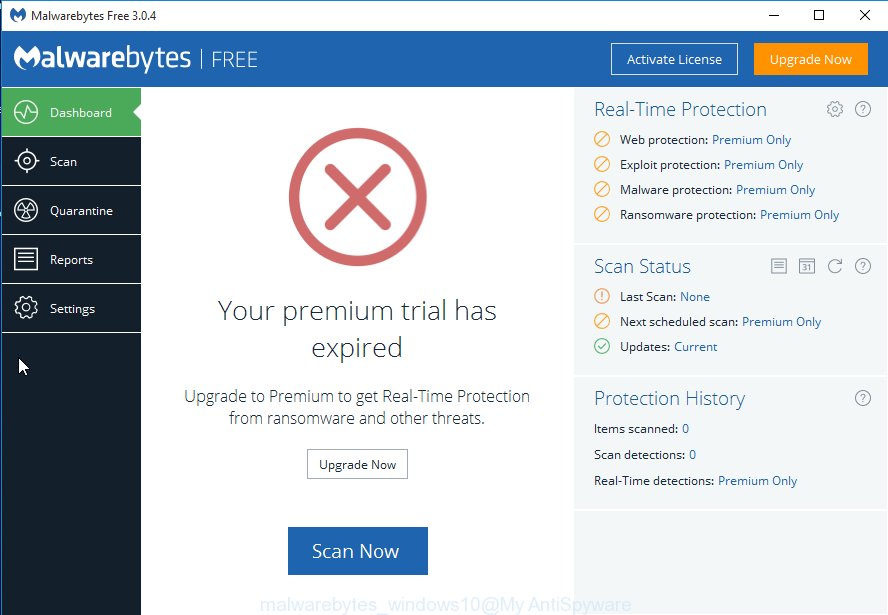
- Download MalwareBytes Anti-Malware from the following link.
Malwarebytes Anti-malware
327040 downloads
Author: Malwarebytes
Category: Security tools
Update: April 15, 2020
- At the download page, click on the Download button. Your web-browser will open the “Save as” dialog box. Please save it onto your Windows desktop.
- Once downloading is finished, please close all applications and open windows on your computer. Double-click on the icon that’s called mb3-setup.
- This will run the “Setup wizard” of MalwareBytes AntiMalware onto your PC. Follow the prompts and don’t make any changes to default settings.
- When the Setup wizard has finished installing, the MalwareBytes Anti-Malware (MBAM) will run and open the main window.
- Further, press the “Scan Now” button for checking your computer for the Web-fast-access that causes a huge number of unwanted pop-ups. This task can take some time, so please be patient.
- After that process is finished, MalwareBytes AntiMalware will display a scan report.
- Make sure all items have ‘checkmark’ and click the “Quarantine Selected” button. When disinfection is finished, you may be prompted to reboot the personal computer.
- Close the Anti-Malware and continue with the next step.
Video instruction, which reveals in detail the steps above.
Run AdwCleaner to delete Web-fast-access ad supported software
AdwCleaner frees your computer from browser hijackers, PUPs, unwanted toolbars, browser extensions and other unwanted programs like Web-fast-access adware that causes internet browsers to open undesired pop-ups. The free removal tool will help you enjoy your PC to its fullest. AdwCleaner uses the (c) Malwarebytes technology to search for if there are undesired programs in your system. You can review the scan results, and select the threats you want to delete.
Click the following link to download the latest version of AdwCleaner for MS Windows. Save it to your Desktop so that you can access the file easily.
225534 downloads
Version: 8.4.1
Author: Xplode, MalwareBytes
Category: Security tools
Update: October 5, 2024
Download and use AdwCleaner on your computer. Once started, press “Scan” button to begin scanning your system for the Web-fast-access that causes web browsers to open undesired pop ups. A system scan can take anywhere from 5 to 30 minutes, depending on your system. While the utility is checking, you can see count of objects and files has already scanned.. When AdwCleaner has completed scanning your system, a list of all items detected is produced. Once you’ve selected what you want to get rid of from your PC, click Clean button.
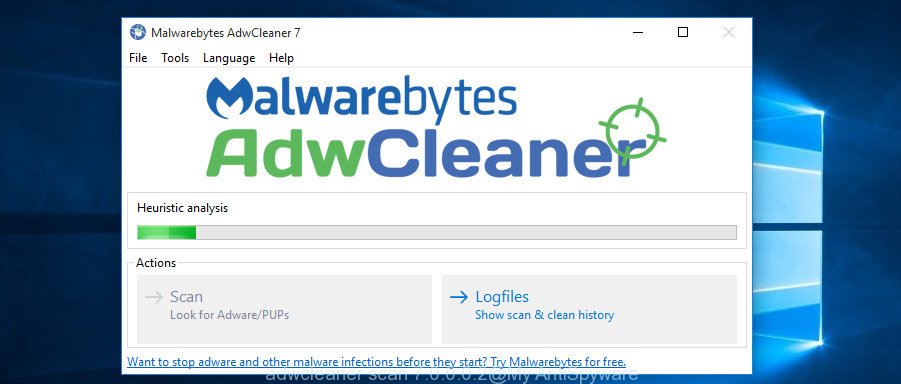
All-in-all, AdwCleaner is a fantastic free utility to free your PC system from any undesired programs. The AdwCleaner is portable application that meaning, you do not need to install it to run it. AdwCleaner is compatible with all versions of MS Windows OS from MS Windows XP to Windows 10. Both 64-bit and 32-bit systems are supported.
Stop Web-fast-access redirect and other unwanted web-sites
If you browse the Internet, you can’t avoid malvertising. But you can protect your browser against it. Download and use an adblocker program. AdGuard is an ad-blocking which can filter out tons of of the malvertising, blocking dynamic scripts from loading harmful content.
Installing the AdGuard ad blocker application is simple. First you’ll need to download AdGuard by clicking on the following link. Save it on your MS Windows desktop.
26839 downloads
Version: 6.4
Author: © Adguard
Category: Security tools
Update: November 15, 2018
Once the download is finished, double-click the downloaded file to start it. The “Setup Wizard” window will show up on the computer screen as displayed in the following example.

Follow the prompts. AdGuard will then be installed and an icon will be placed on your desktop. A window will show up asking you to confirm that you want to see a quick instructions as on the image below.

Click “Skip” button to close the window and use the default settings, or click “Get Started” to see an quick guide that will help you get to know AdGuard better.
Each time, when you launch your computer, AdGuard will start automatically and block ads, web-pages like Web-fast-access, as well as other harmful or misleading web-sites. For an overview of all the features of the program, or to change its settings you can simply double-click on the AdGuard icon, which can be found on your desktop.
How did you get infected with Web-fast-access adware
Usually, adware gets into your PC as part of a bundle with free software, sharing files and other unsafe software that you downloaded from the Web. The makers of this adware pays software creators for distributing ad supported software within their software. So, optional programs is often included as part of the setup file. In order to avoid the setup of any Web-fast-access ad supported software that redirects your internet browser to intrusive ad web pages: select only Manual, Custom or Advanced installation method and uncheck all third-party applications in which you are unsure.
To sum up
After completing the step by step instructions shown above, your personal computer should be free from Web-fast-access ‘ad supported’ software which made to display lots of unwanted ads. The FF, Google Chrome, Internet Explorer and Microsoft Edge will no longer reroute you to various unwanted web-sites. Unfortunately, if the instructions does not help you, then you have caught a new adware, and then the best way – ask for help in our Spyware/Malware removal forum.




















